We may not have the course you’re looking for. If you enquire or give us a call on +0800 780004 and speak to our training experts, we may still be able to help with your training requirements.
Training Outcomes Within Your Budget!
We ensure quality, budget-alignment, and timely delivery by our expert instructors.
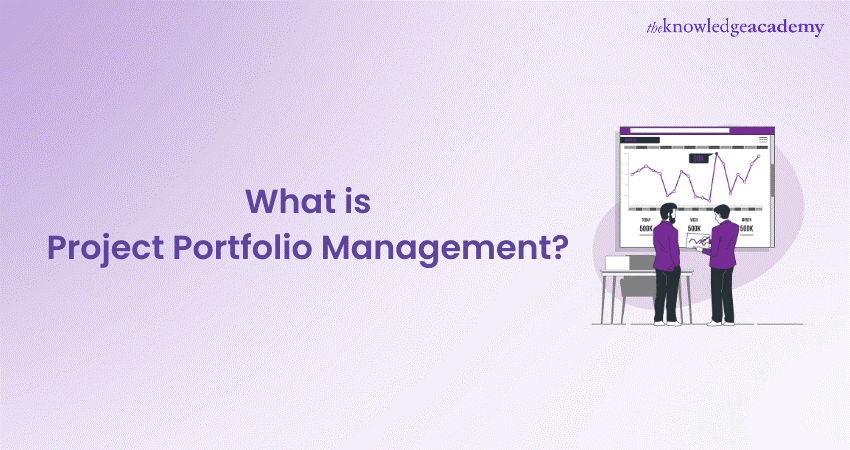
In a world where businesses juggle multiple projects at once, how do they ensure each one is contributing to their overall success? This is where the significance of Project Portfolio Management (PPM) comes in. But What is Project Portfolio Management, and how can it benefit your business? Understanding the process can be a game-changer in achieving long-term goals while maintaining efficiency.
In this blog, we’ll explore What is Project Portfolio Management truly means and why it’s a game-changer for businesses of all sizes. From understanding its key benefits to uncovering the role of a Project Portfolio Manager, you’ll gain insights into how PPM can transform your project approach. Ready to unlock the full potential of your Project Portfolio? Let’s dive in!
Table of Contents
1) What is Project Portfolio Management?
2) Benefits of Project Portfolio Management
3) Project Portfolio Management vs Project Management
4) The Five Steps of Project Portfolio Management
5) What is the Role of the Project Portfolio Manager?
6) Five Essential Project Portfolio Management Processes
7) What Types of Industries and Companies Benefit From Project Portfolio Management?
8) Project Portfolio Management Tools
9) Conclusion
What is Project Portfolio Management?
Project Portfolio Management is a tactical method for managing and evaluating multiple projects simultaneously. Its main goal is to align projects with the organisation's overall objectives. PPM focuses on maximising resource utilisation and delivering a higher return on investment. Unlike Project Management, PPM looks at the broader picture and portfolio-wide performance. It helps decision-makers prioritise projects and balance risks.
PPM ensures effective resource allocation and tracks project outcomes across the portfolio. This approach helps organisations select, manage, and optimise projects for long-term success. By using PPM, companies can make informed, data-driven decisions efficiently.
Benefits of Project Portfolio Management
By harnessing the benefits of Project Portfolio Management, organisations can strategically plan and manage projects to achieve optimal results. The key advantages of PPM include:
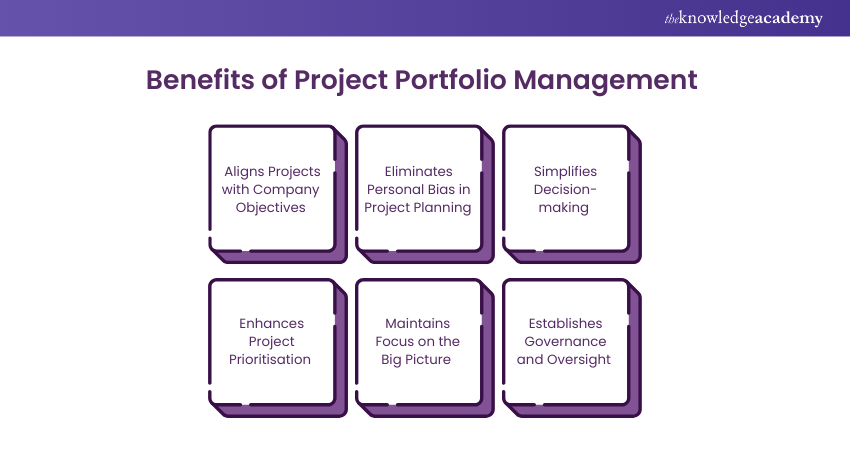
a) Aligns Projects with Company Objectives
PPM fosters clear communication within teams, ensuring that projects align with overarching business goals. This approach helps avoid project failure due to poorly defined objectives.
b) Eliminates Personal Bias in Project Planning
PPM removes subjective preferences, focusing on project selection based on risks, business goals, and available resources. Quantitative and qualitative techniques, such as ranking and scoring methods, guide decisions.
c) Simplifies Decision-making
PPM employs a standardised framework for decision-making, helping stakeholders resolve conflicts over competing priorities and resources. It ensures that project decisions are objective and strategic.
d) Enhances Project Prioritisation
PPM enables teams to allocate resources to the most valuable projects. By focusing on projects that align with organisational goals, teams can effectively meet customer needs and regulatory demands.
e) Maintains Focus on the Big Picture
PPM ensures that teams prioritise projects with real value, preventing them from losing sight of broader strategic goals. It avoids overburdening teams with low-priority tasks.
f) Establishes Governance and Oversight
PPM introduces a governance model that provides an overall view of all projects within the organisation. It allows for contingency planning and data-driven decision-making, guiding the organisation towards its long-term goals.
Elevate your Project Manager experience with our comprehensive Project Management Courses. Embark on your journey to success today!
Project Portfolio Management vs Project Management
While both Project Portfolio Management and Project Management’s objective is to achieve successful project outcomes, they differ in scope and focus.
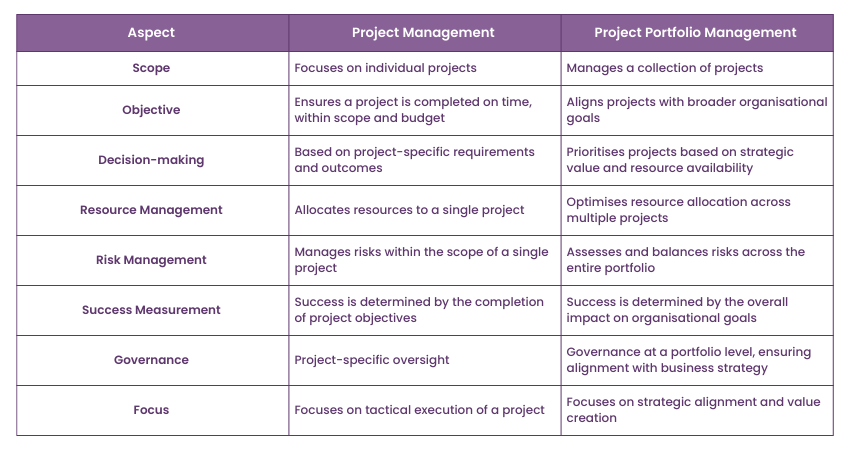
The Five Steps of Project Portfolio Management
These are the five steps of Project Portfolio Management:
1) Identify the Guiding Objectives of the Business
a) Define the organisation’s strategic goals and objectives.
b) Ensure that all projects align with these long-term business priorities.
c) Focus on selecting projects that contribute directly to overall business success.
2) Collect Project Ideas for Your Portfolio
a) Gather potential project ideas and proposals from various internal sources.
b) Collect input from departments, teams, or leadership based on market trends, customer needs, and internal improvements.
c) Consider a broad range of projects to foster innovation.
3) Select the Best Projects for Your Portfolio
a) Assess projects based on criteria such as strategic alignment, risk, resource availability, and ROI.
b) Prioritise projects that offer the best balance between these factors.
c) Select projects that contribute the most value and align with business goals.
4) Validate Portfolio Feasibility and Initiate Projects
a) Distribute necessary resources like budget, personnel, and equipment to selected projects.
b) Ensure optimal utilisation of resources across all projects.
c) Prevent resource overload by balancing resource allocation effectively.
5) Execute and Manage Your Project Portfolio
a) Continuously track project performance, progress, and risks.
b) Make adjustments to timelines, scope, or resources as needed.
c) Conduct frequent portfolio reviews to ensure alignment with changing business priorities.
Join the Portfolio Management Green Belt Certification Course to develop skills that transform project outcomes and strategies!
What is the Role of the Project Portfolio Manager?
Key responsibilities of Project Portfolio Manager include:
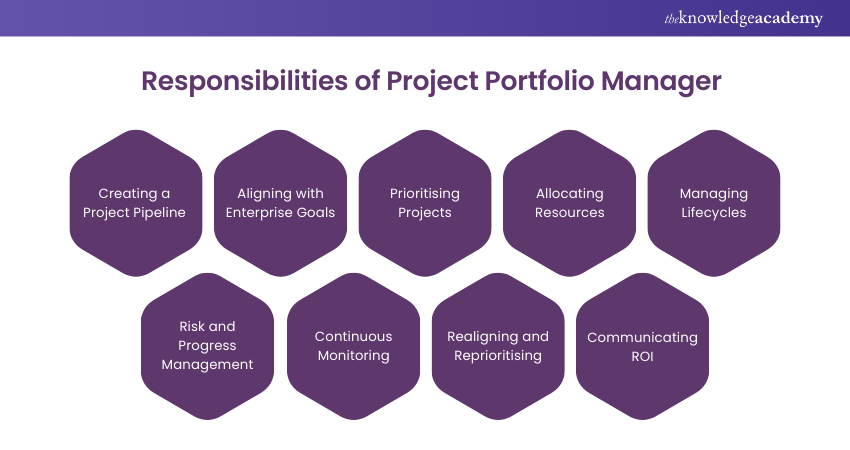
a) Creating a Project Pipeline: Developing a pipeline of projects and programs.
b) Aligning with Enterprise Goals: Ensuring the project pipeline aligns with the organisation’s strategic objectives.
c) Prioritising Projects: Prioritising projects and programs based on benefits and challenges.
d) Allocating Resources: Distributing resources effectively across projects.
e) Managing Lifecycles: Ensuring projects and programs are managed efficiently throughout their lifecycles.
f) Risk and Progress Management: Managing risks, tracking progress, and addressing issues within the portfolio.
g) Continuous Monitoring: Continuously monitoring and reporting on the portfolio’s status.
h) Realigning and Reprioritising: Adjusting the portfolio in response to shifts in enterprise objectives or circumstances.
i) Communicating ROI: Communicating the expected Return On Investment (ROI) for planned projects and programs to enterprise leadership.
Gain practical Jira skills and boost your Project Management performance with our Jira Training – sign up now!
Five Essential Project Portfolio Management Processes
PPM relies on five key Project Management Processes to achieve these goals, which are mentioned below:
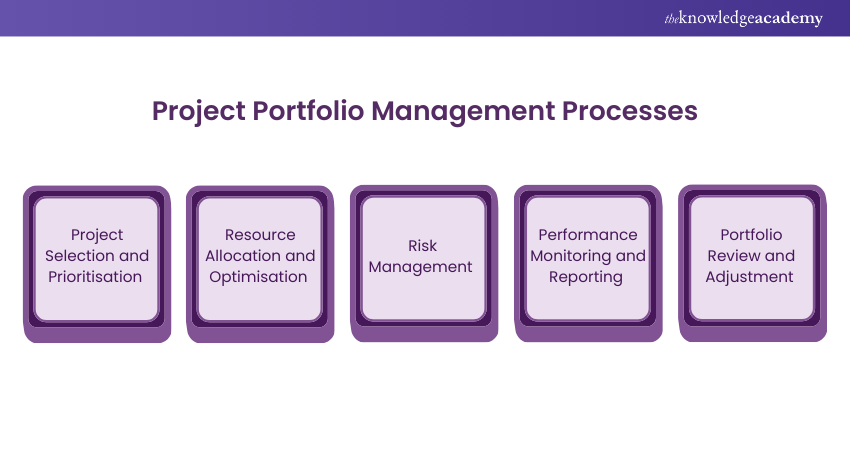
1) Project Selection and Prioritisation
a) Evaluate projects based on value, strategic alignment, risks, and ROI.
b) Select projects that offer the most benefit to the organisation.
c) Prioritise projects to focus on those that contribute most to long-term success.
2) Resource Allocation and Optimisation
a) Distribute available resources (budget, personnel, technology) efficiently across the portfolio.
b) Avoid resource conflicts and ensure optimal use of resources.
c) Maximise the impact of resources while ensuring timely project completion.
3) Risk Management
a) Identify potential hazards that may harm individual projects or the overall portfolio.
b) Determine the probability and impact of these hazards.
c) Develop mitigation methods to reduce the impact of risks on portfolio success.
4) Performance Monitoring and Reporting
a) Monitor Key Performance Indicators (KPIs), deadlines, budgets, and quality across all projects.
b) Create regular reports that provide updates on project and portfolio development.
c) Identify problems early and take steps to fix them to keep projects on track.
5) Portfolio Review and Adjustment
a) Conduct regular reviews to ensure the portfolio remains aligned with business objectives.
b) Reevaluate, reprioritise or modify projects based on changing business needs.
c) Adjust the portfolio to respond to shifts in strategic goals or project performance.
Develop advanced Risk Management expertise to ensure project success with our Risk Management Black Belt Training - join now!
What Types of Industries and Companies Benefit from Project Portfolio Management?
Project Portfolio Management is a versatile approach that can benefit a wide range of industries and companies. Here are some types of industries and companies that can particularly benefit from PPM:
a) Information Technology (IT):
IT companies often manage numerous projects simultaneously, such as software development, system upgrades, and cybersecurity initiatives. PPM helps in Prioritising projects, optimising resource allocation, and ensuring alignment with strategic goals.
b) Manufacturing:
Manufacturing firms handle projects related to production processes, supply chain management, and product development. PPM aids in improving efficiency, reducing costs, and ensuring timely project completion
c) Healthcare and Pharmaceuticals:
Healthcare organisations and pharmaceutical companies manage projects like clinical trials, facility upgrades, and technology implementations. PPM ensures compliance with regulations, optimises resource use, and aligns projects with patient care goals.
d) Financial Services:
Financial institutions benefit from PPM by managing projects related to compliance, Risk Management, and new financial product development. PPM helps in efficient resource allocation and strategic alignment.
e) Telecommunications:
Telecom companies use PPM to manage network upgrades, service expansions, and technology rollouts. PPM ensures projects are aligned with business objectives and customer needs, improving service delivery.
f) Government and Public Sector:
Government agencies use PPM to manage public projects, infrastructure developments, and policy implementations. PPM ensures efficient use of taxpayer funds and alignment with public goals.
g) Construction and Engineering:
Construction and engineering firms manage multiple projects such as building developments, infrastructure projects, and renovations. PPM helps in prioritising projects, managing resources, and mitigating risks.
h) Education and Research:
Educational institutions and research organisations manage projects related to curriculum development, research initiatives, and facility improvements. PPM ensures projects align with educational goals and research priorities.
i) Energy and Utilities:
Energy companies, including those in oil, gas, and renewable energy, use PPM to manage exploration projects, facility upgrades, and sustainability initiatives. PPM optimises resource allocation and strategic alignment.
j) Retail and Ecommerce:
Retailers benefit from PPM by managing projects related to store openings, inventory management, and marketing campaigns. PPM ensures alignment with strategic goals and market trends, improving customer satisfaction.
PPM helps in creating Project Charters, prioritising projects, optimising resource allocation, and ensuring alignment
Project Portfolio Management Tools
Several PPM (Project Portfolio Management) tools are widely used across industries to streamline project management processes and optimise project portfolios. Here are some popular examples:
1) Microsoft Project: Microsoft Project is a comprehensive project management software suite that provides a range of tools for planning, scheduling, and managing projects of all sizes. It offers both on-premises and cloud-based versions.
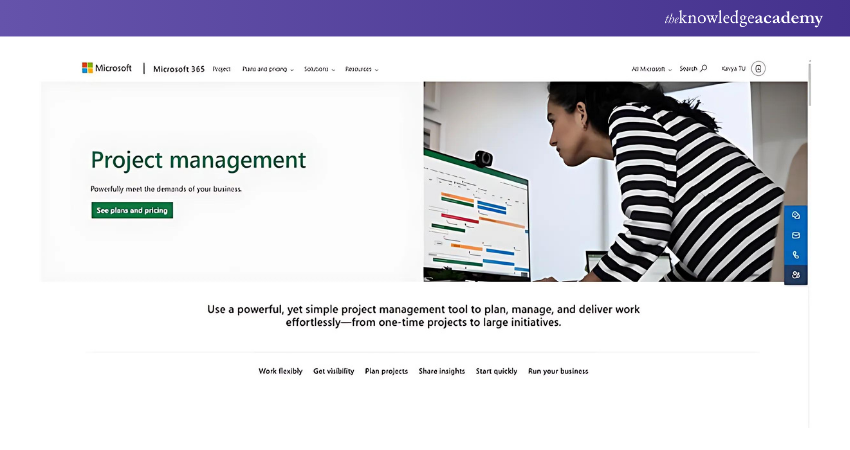
Key Features:
a) Gantt Charts: Visualise project timelines and dependencies to plan and track project progress.
b) Resource Management: Allocate resources efficiently and track resource availability to avoid overallocation.
c) Task Management: Break down projects into tasks, assign them to team members, and track task progress.
d) Reporting: Generate customisable reports and dashboards to monitor project performance and communicate status to stakeholders.
e) Integration: Integrates with other Microsoft Office applications like Excel and SharePoint, as well as third-party tools like Teams and Power BI.
f) Use Cases: Microsoft Project is commonly used in industries such as construction, engineering, IT, and manufacturing to manage complex projects and portfolios.
2) Planview: Planview offers a suite of PPM solutions that enable organisations to align projects with business objectives, optimise resource utilisation, and track portfolio performance.
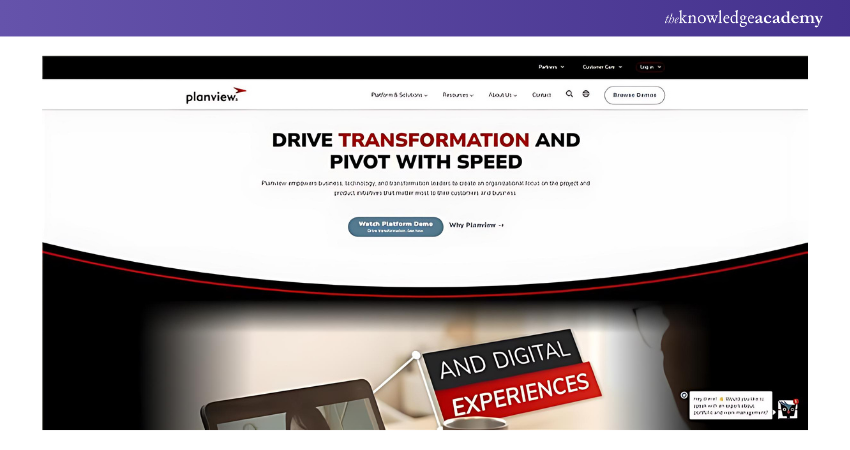
Key Features:
a) Portfolio Management: Prioritise projects, balance resource capacity, and align Project Portfolios with strategic goals.
b) Financial Management: Track project budgets, forecast costs, and analyse financial performance to ensure projects stay within budget.
c) Resource Management: Allocate resources based on skills, availability, and project demands to maximise productivity.
d) Scenario Planning: Model different portfolio scenarios to evaluate the impact of changes and make informed decisions.
e) Analytics: Gain insights into portfolio performance with advanced analytics and reporting capabilities.
f) Use Cases: Planview is widely used in industries such as healthcare, financial services, telecommunications, and government for managing large-scale projects and portfolios.
3) Jira Portfolio: Jira Portfolio is a PPM tool offered by Atlassian, designed to help teams plan, track, and manage Project Portfolios within the Jira ecosystem.
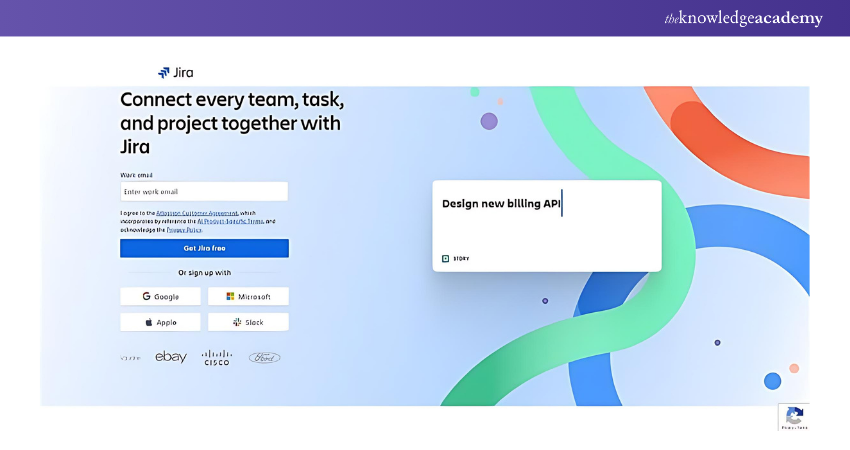
Key Features:
a) Dependency Management: Visualise and manage dependencies between projects to ensure smooth execution.
b) Roadmaps: Create interactive roadmaps to communicate project plans and timelines to stakeholders.
c) What-If Analysis: Model different scenarios to assess the impact of changes on Project Portfolios.
d) Agile Planning: Integrate with Jira Software to align agile teams and portfolios and track progress.
e) Integration: Seamlessly integrates with Jira Software and other Atlassian products for end-to-end visibility and collaboration.
f) Use Cases: Jira Portfolio is commonly used by software development teams and agile organisations to manage iterative projects and portfolios.
4) ServiceNow PPM: ServiceNow's PPM solution provides capabilities for managing Project Portfolios, resources, and finances within a single platform.
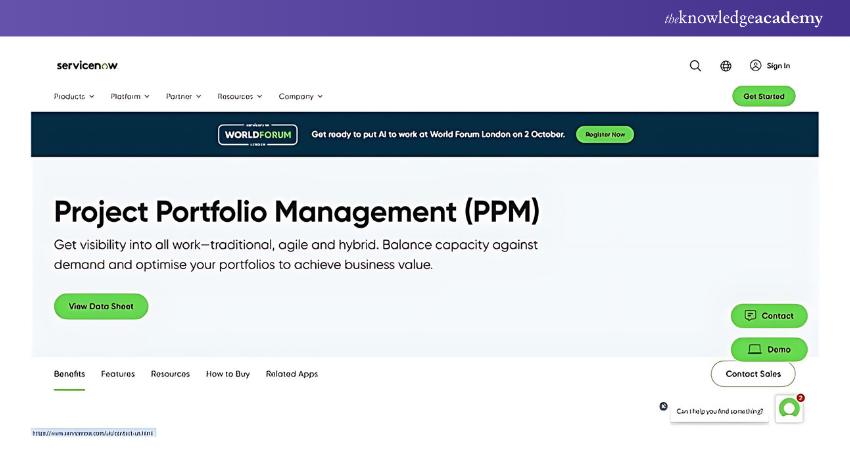
Key Features:
a) Demand Management: Capture, evaluate, and prioritise project demands based on business objectives and resource availability.
b) Financial Planning: Create project budgets, track costs, and manage financial resources to ensure projects stay on budget.
c) Resource Management: Allocate resources effectively and track resource utilisation to maximise productivity.
d) Governance: Establish governance processes and controls to ensure projects align with organisational policies and standards.
e) Integration: Integrates with other ServiceNow solutions, such as IT Service Management (ITSM) and Enterprise Service Management (ESM), for streamlined operations.
f) Use Cases: ServiceNow PPM is widely used by IT organisations, enterprises, and service-oriented businesses to manage IT projects, services, and portfolios.
5) Smartsheet: Smartsheet is a cloud-based collaboration and work management platform that offers PPM capabilities for planning, tracking, and managing projects and portfolios.
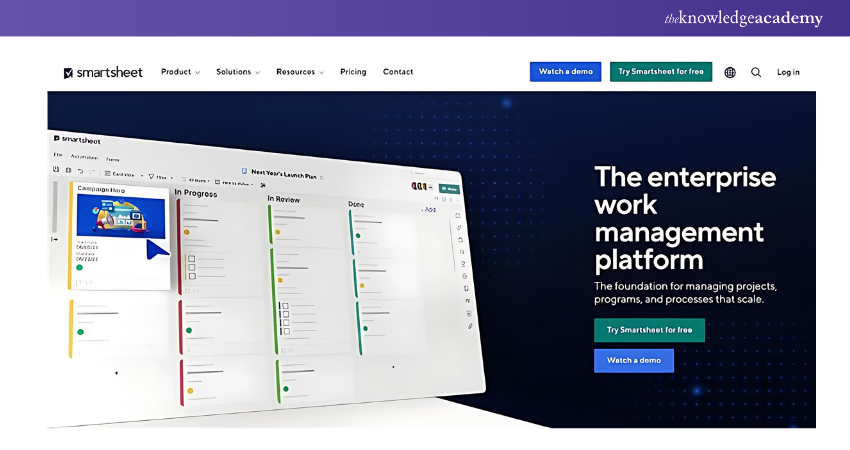
Key Features:
a) Project Sheets: Create customisable project sheets to plan and track project tasks, timelines, and dependencies.
b) Resource Management: Allocate resources, track resource availability, and manage workloads to ensure project success.
c) Dashboards and Reports: Generate interactive dashboards and reports to monitor project performance and communicate status to stakeholders.
d) Automation: Automate repetitive tasks and workflows to improve efficiency and productivity.
e) Integration: Integrates with other business applications like Microsoft Office, Google Workspace, and Salesforce for seamless data exchange.
f) Use Cases: Smartsheet is used by a wide range of industries, including marketing, consulting, education, and non-profit organisations, for managing projects, processes, and workflows.
Learn how to streamline tasks and manage projects efficiently with our Smartsheet Training – join now!
Conclusion
We hope this blog has provided you with a clear understanding of What is Project Portfolio Management and how it can streamline your project efforts. By applying PPM, you can align projects with business goals, optimise resources, and drive overall project success. Embrace PPM to drive smarter decision-making and maximise project outcomes!
Join the Portfolio Management Black Belt Training and enhance your skills for career growth and success!
Frequently Asked Questions

A career path for a Project Portfolio Manager typically starts with roles in Project Management. From there, they advance to senior Project Management positions and portfolio oversight roles, eventually reaching leadership roles like PMO Director or Strategic Program Manager.

According to Glassdoor, the highest pay scale for a Project Portfolio Manager role is £100K annually, depending on experience and responsibilities.

The Knowledge Academy takes global learning to new heights, offering over 30,000 online courses across 490+ locations in 220 countries. This expansive reach ensures accessibility and convenience for learners worldwide.
Alongside our diverse Online Course Catalogue, encompassing 17 major categories, we go the extra mile by providing a plethora of free educational Online Resources like News updates, Blogs, videos, webinars, and interview questions. Tailoring learning experiences further, professionals can maximise value with customisable Course Bundles of TKA.

The Knowledge Academy’s Knowledge Pass, a prepaid voucher, adds another layer of flexibility, allowing course bookings over a 12-month period. Join us on a journey where education knows no bounds.

The Knowledge Academy offers various Project Management Courses, including Introduction to Project Management Course, Project Management Office (PMO) Fundamentals Course and Certified Digital Services Project Manager Course. These courses cater to different skill levels, providing comprehensive insights into Project Management Methodologies.
Our Project Management Blogs covers a range of topics offering valuable resources, best practices, and industry insights. Whether you are a beginner or looking to advance your Business Improvement skills, The Knowledge Academy's diverse courses and informative blogs have you covered.
Upcoming Project Management Resources Batches & Dates
Date
 Introduction to Project Management Course
Introduction to Project Management Course
Fri 10th Jan 2025
Fri 14th Mar 2025
Fri 9th May 2025
Fri 15th Aug 2025
Fri 10th Oct 2025
Fri 12th Dec 2025







 Top Rated Course
Top Rated Course



 If you wish to make any changes to your course, please
If you wish to make any changes to your course, please


